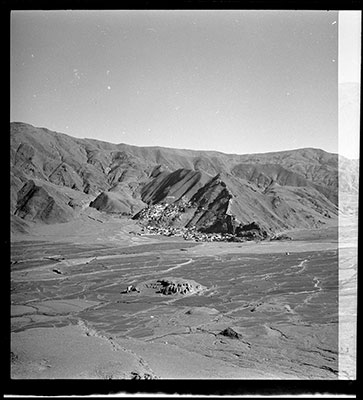
2001.59.15.64.1 (Film negative)


2001.59.15.64.1 (Film negative)

Hugh E. Richardson
Hugh Richardson
1949
Chyongye Valley Region > Chyongye
2001.59.15.64.1
55 x 55 mm
Negative film nitrate
Donated August 2001
The executors of the estate of Hugh E. Richardson
Richardson's 1949 tour of the Yarlung and Chyongye valleys
This image has been flipped during scanning. You can compare the correct image above
Negative Album 9 No. 64
Manual Catalogues - Notes on negative album (slip cover) - 'Drikhung. Chongye. etc.' in Richardson's hand in white. (Yellow spine label) 'DRIKHUNG. CHONGYE. KOTSHAL. RGYAMA. Ganden 1948'. (Cover) - '9 DRIKHUNG. CHONGYE. YARLUNG. GYAMA. GANDEN' [KC 15/5/2006]
Manual Catalogues - Notes in negative index - Folio 64. ''Phyong-rgyas from bang so.' [KC 30/5/2006]
Manual Catalogues - Richardson's Handlist, Negative book '9' 'Drikhung, Chongye etc.' [no] 60. ' Phyong-rgyas is in a valley south of the Brahmaputra at Rtse-thang, and west of the Yarlung valley. There is a dzong on the site of a palace of the early kings called 'Phying-ba stag-rtse; and also a monastery, Ri-bo-bde-chen, of the Dge-lugs-pa sect. East of the village in a small valley are the tombs of the kings of Tibet. See Mkhyen-brtse p.130 and G. Tucci. The Tombs of the Tibetan Kings. Rome 1950.' [KC 30/5/2006]
Manual Catalogues - Richardson's Handlist, Negative book '9' 'Drikhung, Chongye etc.' [nos] 64-69 . (especially 67-9) Burial mounds of the kings etc. See Tucci. Tombs.' [KC 22/5/2006]
Research publication - High Peaks, Pure Earth , H. E. Richardson, London, Serindia Publications, 1998, plate 3. "From same point as Plate 2. The largest mound is attributed to Sad-na-legs. Smaller mounds are those of Mu-ne, Mu-rug and Ljang-tsha Lhas-bon. A pillar may be seen near the right side of the largest mound. 'Phyong-rgyas villae and Rdzong, site of Phying-ba Stag-rtse, and Ri-bo Bde-chen monastery in the distance."
Research publication - Mk'yen Brtse's Guide to the Holy Places of Central Tibet, Alfonsa Ferrari, 1958, Serie Orientale Roma XVI, Roma: Is. M. E. O. plate 30.
Other Information - Location: Richardson wrote an article about the location and the historical significance of the early burial grounds in the Chyonggye valley near Yarlung in Central asiatic Journal , 8,2 (1963), pp. 73-92 reproduced in High Peaks, Pure Earth , London, Serindia Publications, 1998, pp. 219-233. "'Phyong-rgyas is some sixty-five miles south-east of Lhasa, near the head of a tributary of the Yar-lung Chu which flows south into the Gtsang-po near Rtse-thang. There, in brooding and majestic solitude, rise the burial mounds of the kings ... . Not far away to the north, at the foot of the hills which enclose the valley, is the village of 'Phyong-rgyas dominated by its rdzong ; and on a sheltered hillside above the village there is the Dge-lugs-pa monastery of Ri-bo bde-chen. Higher up the steep ridge on which the rdzong stands are the ruins of what is traditionally identified with Phying-ba'i Stag-rtse, the ancient stronghold of the Tibetan kings." (219-220) Also, "About twelve miles up the ['Phyong-rgyas] valley and visible from a considerable distance are the brooding forms of the great burial tumuli ( bang-so ) (1949) of the Tibetan kings." (320) "The photographs show that some of the surviving mounds are larger than others. The smaller mounds are those attributed to Ljang-tsha Lhas-bon, Mu-rug and Mu-ne Btsan-po. Neither of the first two was enthroned as king ... [and the last] may not have been enthroned as king." (225) [KC 17/10/2006]
For Citation use:
The Tibet Album.
"Settlement of Chyongye with burial mounds "
05 Dec. 2006. The Pitt Rivers Museum.
<http://tibet.prm.ox.ac.uk/photo_2001.59.15.64.1.html>.
For more information about photographic usage or to order prints, please visit the The Pitt Rivers Museum.
© The Pitt Rivers Museum